The unenviable fate of a pioneer. “Great Eastern” is a locomotive of progress, covered in notoriety (7 photos)
Professions involving risk or harsh conditions over time acquire many superstitions. And to most, some maritime traditions may seem funny and incomprehensible, but sailors, who time and again challenge the water elements, sacredly honor such traditions and beliefs that have come from the depths of centuries. 
"Great Eastern" before launching
Studying the history of the world fleet, every now and then you can come across some ships over which, judging by their history, an evil fate really seemed to hang. It’s as if they were cursed, otherwise how can one explain the constant occurrence of accidents and constant failure? One or two incidents can be attributed to chance, but when it becomes a system, it becomes difficult to find logical explanations. They shied away from such ships, they were afraid of them and, even despite their often outstanding performance characteristics, they wanted nothing to do with them.
The middle of the 19th century was a stage of rapid development of technology. People who remembered the Battle of Trafalgar and admired the power and aesthetics of sailing ships now saw steam-powered ships being regularly launched one after another. And it was Europe, drawing resources from its colonies and able to afford such development, that became the stronghold of technological development. 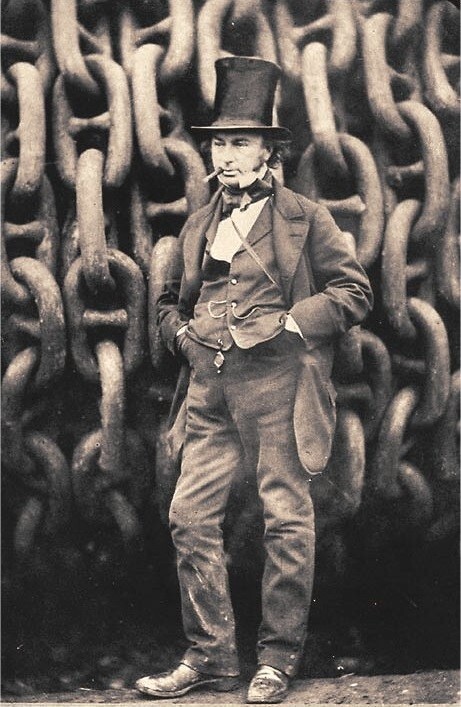
Isambard Kingdom Brunel with the chains used to launch the Great Eastern in the background, photo 1857
Isambard Kingdom Brunel was one of the most prominent engineers in Britain, who contributed a lot to the industrial revolution. According to his projects and drawings, 25 railways, 8 piers and docks, five suspension bridges and 125 railways were built, some of which are still in use today. But at the end of his life, Brunel decided to create something truly titanic. A huge ship that would contain all the achievements of scientific thought of that time and would be so large that it would cover the distance from England to India without calling at any port to refuel.
This was a really serious goal. Brunel already had behind him the design and construction of two ships that were outstanding in their class, both in size and in some technical indicators, but now he set out to surpass everything that came before. Even at the design stage, the ship was called "Leviathan", but was later renamed "Great Eastern".
However, the circumstances were such that it seemed that fate itself was against the completion of this project. Having created the project in 1852, Brunel began to implement it only in May 1854. The ship was launched on January 31, 1858. The designer called it “Big Child” and loved this project very much, devoting all his soul and resources to it. However, financial difficulties, accidents with workers during construction and many unpleasant rumors circulating around the ship undermined the author’s health. During the first voyage of the Great Eastern, an explosion occurred in the boiler room. The accident was promptly eliminated, however, according to contemporaries, this was the last straw for Brunnel. The engineer suffered an apoplexy, or, according to other versions, a heart attack, after which he died in September 1859. 
Great Eastern on its first transatlantic voyage
Nevertheless, his brainchild, the Great Eastern, actually turned out to be the greatest in many ways. To this day it is the largest ship built before the 20th century. The ship's length of 211 meters was surpassed only in 1899, its 18,915 gross register tons was surpassed in 1901, its passenger capacity of 4,000 people was surpassed in 1912, and its beam of 25.21 meters was surpassed only in 1907. The size of the ship's paddle wheels was also record-breaking, as were its five chimneys. The construction of such a giant was of great importance for the industry of those years and contributed to the spread of iron and steel in the construction of ships of all classes and sizes. But the history of the Great Eastern, alas, was not as outstanding as its parameters.
On the first trip, as mentioned above, there was an accident with a steam boiler. From a financial point of view, the ship also turned out to be a failure already at the time of its commissioning. The initial funds of the designer were not enough, and more and more investors had to be attracted. The Great Eastern's first voyage across the Atlantic took place with virtually no passengers. Of the 418 crew members on board, there were only 35 passengers who bought a ticket, and 8 people from the owner’s company for objective control. It was planned to recoup the funds spent on this giant in the USA by showing the ship to spectators: earnings were expected to be at least $700,000. The meeting of the ship in New York was arranged with great pomp, dozens of ships and many thousands of people were present. However, misfortune overtook the ship here too: the price for a tour of the giant ship, which personified progress, was equal to a dollar, which was excessive, according to people, and it was practically impossible to earn money. Subsequently, the ship made several voyages along the US coast, but the funds received barely covered the operating costs. In addition, various emergencies on board did not stop. 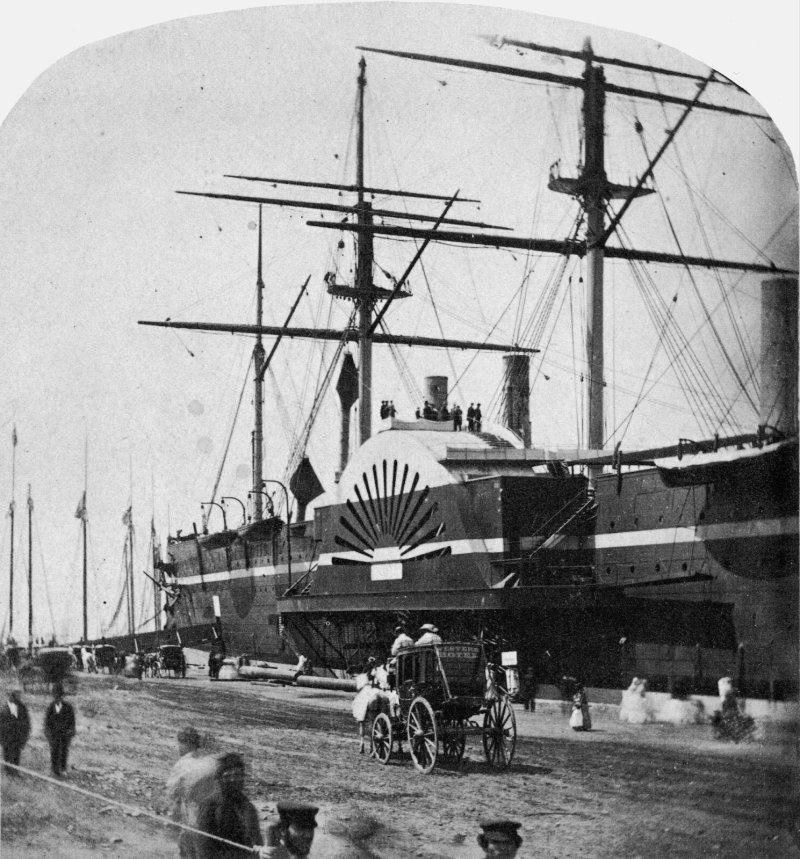
Great Eastern in New York, photo 1860
There were cases of outright negligence. Thus, on one of the trips, tickets for the same cabins were sold to some buyers at once, while others remained empty. Five transport police officers sent to catch pickpockets were assigned to a barn for transported animals, which was widely reported in the press and also did not add to the popularity of the ship and the company. The last straw was the Great Eastern's march to Halifax. There, after passing the lighthouse, where it was necessary to pay the amount of costs according to the tonnage, they presented an incredible bill for those times - $ 1,750. Negotiations with the governor of Halifax, who was responsible for the fees, failed, and the company recalled the ship back to England. As a result, the first transatlantic voyage of the Great Eastern proved the engineering success of the new type of ships and their promise, but was a complete failure from a financial point of view.
Meanwhile, failures continued to plague the ship. In England, while in port, the Great Eastern collided with the HMS Blenheim, causing significant damage. One bright spot was the fact that Great Eastern was hired by the Royal Armed Forces. Once again off the coast of North America at the outbreak of the American Civil War, the ship was used to transport 2,144 soldiers, 473 passengers and 122 horses, which were transported to Quebec in 8 days and 6 hours. Delivery of cargo of this volume in such a short period of time was a record. Which, however, was somewhat undermined by the port services, unsuited to work with a giant ship - unloading took two days. The military highly appreciated the ship's capabilities, but still refused to renew the contract. 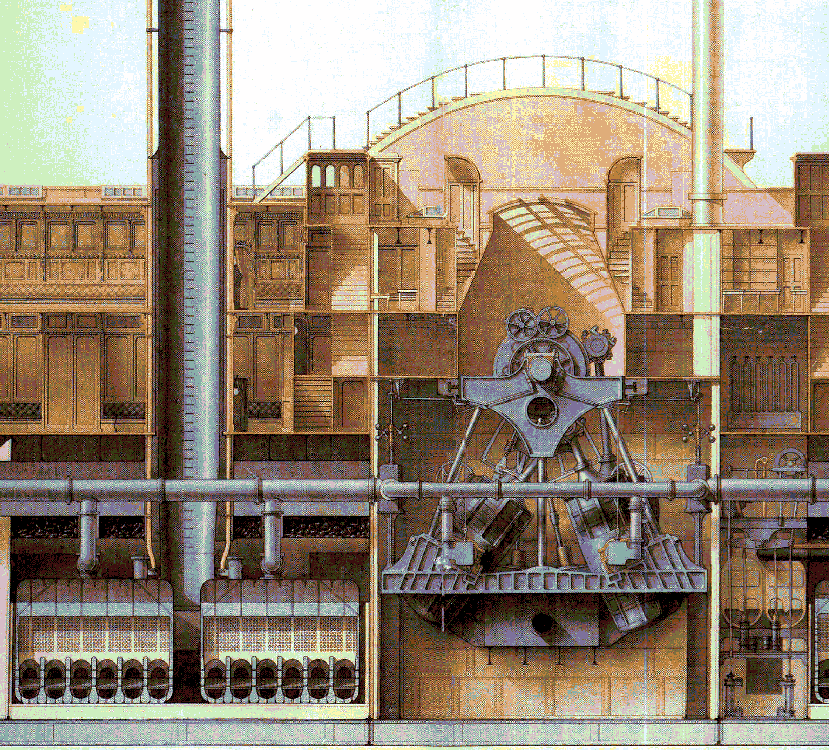
Longitudinal section of the Great Eastern, engine room
In September 1861, two days' journey from Liverpool, the ship was caught by a major hurricane and spent three days under its blows. All the sails were torn off, the paddle wheels were damaged, the rudder was twisted and the propeller was seriously damaged. Having made local repairs with great difficulty, the ship reached Ireland. There, while being put in for repairs, he again distinguished himself by tearing off the anchor of one of the moored ships. In addition, one crew member died due to the steering wheel spinning in the opposite direction.
After undergoing repairs and making several routine flights, in August 1862, the Great Eastern again had an accident. Not far from New York at two o'clock in the morning he hit the bottom of an unmarked rock at a depth of about 8 meters. Thanks to the double hull - another innovation - the team at first did not even understand what had happened, and decided that the ship had caught a sandbank. Only after arriving at the port it became clear that water had filled a significant part in the gap between the outer and inner hulls, and the ship had a slight list. But, despite the hole 25 meters long, the ship stayed afloat. There were simply no docks to repair such a giant, and the hole had to be patched by building a caisson along the side, which resulted in huge expenses and months of downtime. The ship was abandoned from further use in 1863, when it finally bankrupted its owner. 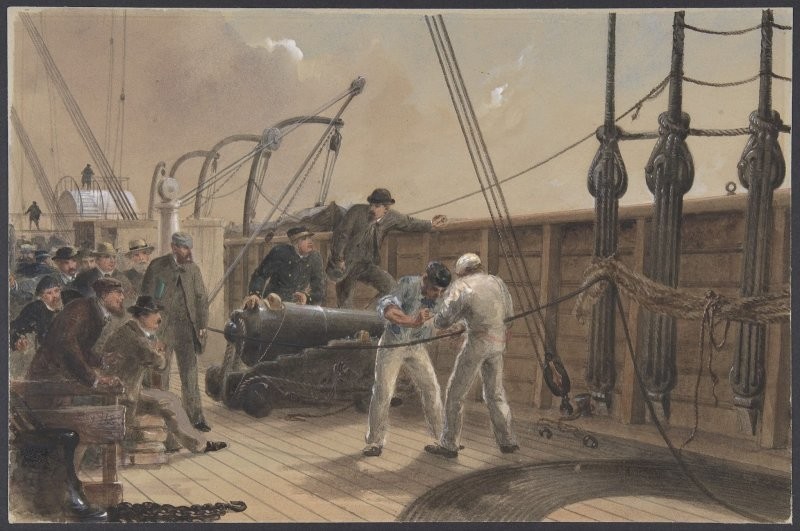
Cable splicing on board the Great Eastern, artist's drawing, 1866
In January 1864, the ship was sold to an American businessman who intended to use it to lay a transatlantic cable. The first cable, with great difficulty, was still laid by sailing ships in 1857-1858. And in 1865, the cable began to be laid with the help of the Great Eastern. Having dismantled part of the interior, 25,835 kilometers of cable were loaded on board, and from July 1865 to July 1866, the laying was successfully completed. But there were some accidents. So, approximately in the middle of the Atlantic, the end of the cable was lost, it was necessary to catch the lost end and splice the cable. In 1869, a cable was laid near Brest, and then a cable in the Indian Ocean. The ship finally ended up in India, as its creator originally intended, and aroused great interest there. This time, excursions to the ship cost 2 rupees, which was quite affordable for local residents. However, the cable-laying career, like that of the transport vessel, was coming to an end. The opening of the Suez Canal in 1869 put an end to any attempts to make cost-effective voyages around the Cape of Good Hope. And because of its size, the Great Eastern could not pass through the Suez Canal. The construction of the special cable-laying vessel Faraday in 1874 finally ended the career of the technological giant. 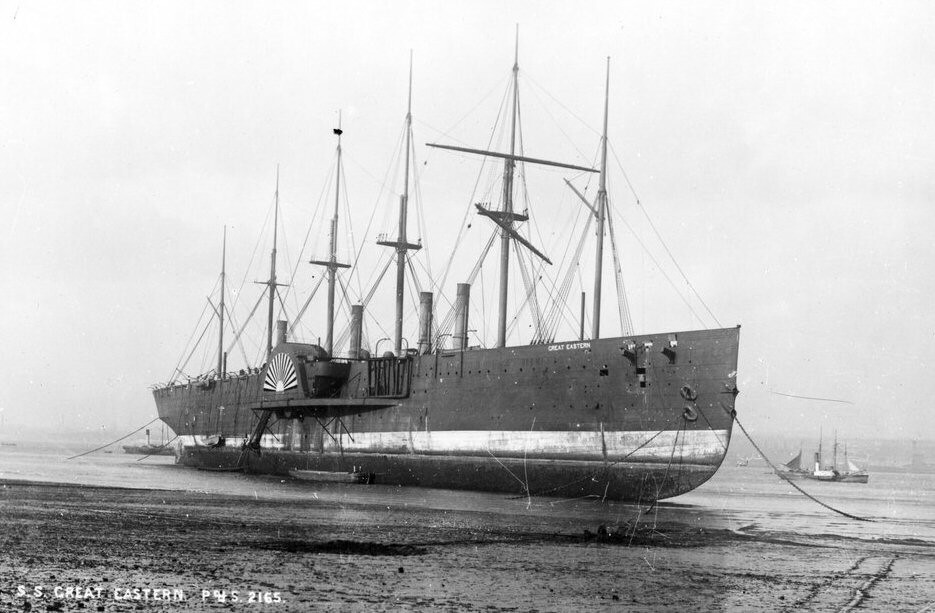
"Great Eastern" washed ashore before being cut up for metal
In 1888 the ship was sold for scrap. As eyewitnesses noted, the ship turned out to be very solidly made, and it took about 18 months to dismantle it. There is also a myth that when dismantling it, the body of a worker was discovered, walled up inside the hull during the construction of the ship. This turned out to be a very popular story, and for a long time there were rumors about a ghost supposedly wandering around the ship and causing all sorts of misfortunes.
It is worth noting that the Great Eastern became a real milestone in shipbuilding. The array of innovative engineering and materials used in its construction, as well as its unrivaled size and capabilities, would make it a truly remarkable ship. However, this did not happen. Errors in design, operation, as well as constant accidents on new equipment led to the fact that the fame of a failed ship was assigned to it. Various conspiracy theorists claim that the ship was cursed, but in reality it was simply significantly ahead of its time. Another couple of decades will pass after it is dismantled for metal, and much larger and technologically advanced ships will already be plying the seas, no longer encountering the problems that a pioneer is always doomed to.


























